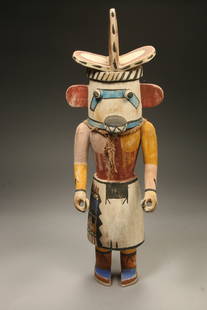
2004 Hopi Polychrome Wood Kachinas, M. Adams
Similar Sale History
Recommended Items






Item Details
Description
M. Adams (Native American, Hopi, 20th to 21st century) ca. 2004 CE, "Hututu." A pair of hand-carved wood kachina (also katsina) figures both signed on their bases by the Hopi artist M. Adams and the date. All is highly stylized, their rounded heads encircled by a collar and painted in black and white. They rest on thick, delineated legs and their cylindrical bodies have their arms tucked inward to their sides. The taller kachina has a teal blue horn protruding from one side, rather than an ear to signify his spirit as the rain priest, Hututu. Both are painted with matching green and red feet, patterned skirts, and stippled necklaces. Size kachina w/ horn: 5.25" W x 9" H (13.3 cm x 22.9 cm); shorter kachina: 3.5" W x 8.5" H (8.9 cm x 21.6 cm)
Hututu and Sai-astasana (Saiyatasha) usually appear as a pair, but are sometimes is sometimes considered to be the same spirit. Hututu and Sai-astasana are both Zuni in origin but adopted into Hopi tradition, and their appearance and functions remain mostly unchanged. Hututu's name comes from the cry he makes.
The Katsinam, supernatural beings who live in the high mountains of the San Francisco Peaks above traditional Hopi territory, speak to the Hopi through costumed dance and song. These dancers emerge from the round ceremonial kivas that are at the center of their communities, singly or in groups, and dance to the music of drums, rattles, and song. Katsina figures (katsina dolls, katsin-tihu), are made of cottonwood root to represent these supernatural beings. Cottonwood is culturally symbolic because the cottonwood tree, once abundant in traditional Hopi lands, grows where water flows - thus, looking across a landscape, lines of cottonwood trees denote a water source in the desert. After carving, the figures are painted all over with whitewash, made from kaolin clay, and then painted in brilliant colors. Originally these were done using yucca brushes. Many katsina are then decorated with other materials, like feathers, cloth, or fur. Katsina dolls are often given objects to hold which indicate their roles.
Provenance: private Alamo collection, Alamo, California, USA, before 2000
All items legal to buy/sell under U.S. Statute covering cultural patrimony Code 2600, CHAPTER 14, and are guaranteed to be as described or your money back.
A Certificate of Authenticity will accompany all winning bids.
PLEASE NOTE: Due to recent increases of shipments being seized by Australian & German customs (even for items with pre-UNESCO provenance), we will no longer ship most antiquities and ancient Chinese art to Australia & Germany. For categories of items that are acceptable to ship to Australia or Germany, please contact us directly or work with your local customs brokerage firm.
Display stands not described as included/custom in the item description are for photography purposes only and will not be included with the item upon shipping.
#167567
Hututu and Sai-astasana (Saiyatasha) usually appear as a pair, but are sometimes is sometimes considered to be the same spirit. Hututu and Sai-astasana are both Zuni in origin but adopted into Hopi tradition, and their appearance and functions remain mostly unchanged. Hututu's name comes from the cry he makes.
The Katsinam, supernatural beings who live in the high mountains of the San Francisco Peaks above traditional Hopi territory, speak to the Hopi through costumed dance and song. These dancers emerge from the round ceremonial kivas that are at the center of their communities, singly or in groups, and dance to the music of drums, rattles, and song. Katsina figures (katsina dolls, katsin-tihu), are made of cottonwood root to represent these supernatural beings. Cottonwood is culturally symbolic because the cottonwood tree, once abundant in traditional Hopi lands, grows where water flows - thus, looking across a landscape, lines of cottonwood trees denote a water source in the desert. After carving, the figures are painted all over with whitewash, made from kaolin clay, and then painted in brilliant colors. Originally these were done using yucca brushes. Many katsina are then decorated with other materials, like feathers, cloth, or fur. Katsina dolls are often given objects to hold which indicate their roles.
Provenance: private Alamo collection, Alamo, California, USA, before 2000
All items legal to buy/sell under U.S. Statute covering cultural patrimony Code 2600, CHAPTER 14, and are guaranteed to be as described or your money back.
A Certificate of Authenticity will accompany all winning bids.
PLEASE NOTE: Due to recent increases of shipments being seized by Australian & German customs (even for items with pre-UNESCO provenance), we will no longer ship most antiquities and ancient Chinese art to Australia & Germany. For categories of items that are acceptable to ship to Australia or Germany, please contact us directly or work with your local customs brokerage firm.
Display stands not described as included/custom in the item description are for photography purposes only and will not be included with the item upon shipping.
#167567
Condition
Both are intact. Some abrasions and nicks to high pointed areas. Stable pressure fissures down the front of the shorter kachina. Red discoloration to the head of the shorter and the side of the taller. Both are signed and dated on the base.
Buyer's Premium
- 26.5%
2004 Hopi Polychrome Wood Kachinas, M. Adams
Estimate $800 - $1,200
4 bidders are watching this item.
Shipping & Pickup Options
Item located in Louisville, CO, usOffers In-House Shipping
Local Pickup Available
Payment

Related Searches
TOP


















































